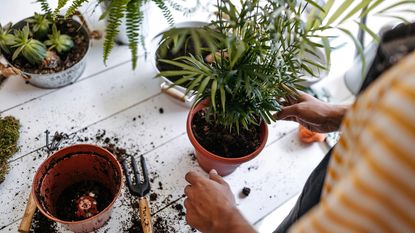Repotting Houseplants: Easy Vs. Difficult


I enjoy repotting houseplants. Okay, you caught me. What I meant to say is I like repotting most houseplants. For anyone who has repotted a cactus, you know what I mean. Fingers full of tingling cacti spines that break off when you try to remove them is not a fun day of gardening. Regardless, here are some of my tips for repotting both easy and difficult houseplants.
Dracaena Repotting is Easy
One of the easiest houseplants I've routinely repotted are dracaena. I find the smaller ones are easy to handle, plus there is plenty of stem between the soil line and the leaves to grab onto when positioning the plant in the new pot. Bushy plants with lots of leaves are more difficult to keep straight in the new pot as I fill it with potting soil.
Here are a few more repotting tips I've learned over the years. These are appropriate for many types of leafy houseplants:
Water the plant I do this the day before I repot my dracaena. I find a hydrated plant is less stressed and seems to adjust better when repotted. Dracaena like moist soil, but it's important to let the soil dry between waterings. Since I won't be watering for a few days after I repot the plant, I'll run water through the soil to flush out salts from fertilizer and mineral build-up from my well water. I then let the pot drain before putting it back on it's drip tray.
Choose the right sized pot. Whether I already have one or need to purchase a new pot, I only want the planter to be 1 or 2 inches (2.5 or 5 cm.) bigger than the current one. Many houseplants, including dracaena, fare better when they are snug in their pot. From experience, I've also learned that putting a small plant in a much larger pot often results in the plant leaning, as it's rootball isn't big enough to provide the stability it needs.
Ensure the pot has adequate drainage. This is especially important as I prefer plastic pots to breakable terra cotta ones. Many gardeners prefer terra cotta as excess water can wick out the sides of the pot and evaporate. If I feel a plastic pot doesn't have sufficient drainage holes, I use a razor knife to enlarge the holes that are there or a drill to made additional ones.
Pick the proper potting soil mix. For repotting a dracaena, I find standard houseplant potting soil is fine. These mixes typically contain peat or compost and perlite or vermiculite. They are formulated to drain well but retain sufficient moisture for most houseplants.
Gardening tips, videos, info and more delivered right to your inbox!
Sign up for the Gardening Know How newsletter today and receive a free download of our most popular eBook "How to Grow Delicious Tomatoes."
Repotting Cactus
I wish I could say repotting all houseplants was as easy as dracaena. However, cacti make up the largest proportion of my houseplant collections and I find repotting these spiky species can be nothing short of painful. Here are a few tips for repotting cacti:
Don't water cactus immediately before repotting. I prefer to water 5 to 7 days prior to repotting. This helps protect the fragile roots. I then wait another 5 to 7 days to water the cactus after repotting it.
Choose a slightly larger pot. Compared to dracaena, cacti are fairly slow growing and don't need to step up to a much larger pot. For a small cactus, I'll repot into a planter that is only 1/2 to 1 inch (1.3-2.5 cm.) bigger and has lots of drainage holes.
Use potting soil formulated for cacti. If I can't easily find the correct cactus growing medium, I use equal amounts of standard potting soil, sand and perlite. I thoroughly mix this in a bucket and have it ready when I begin the repotting process.
Use a sponge. Gently wrapping a sponge around the body of the cactus is the best way to avoid the spikes. I prefer the super soft tan sponges with the big holes. I'll cut them down if they are too cumbersome for my smaller cacti.

Laura Miller has been gardening all her life. Holding a degree in Biology, Nutrition, and Agriculture, Laura's area of expertise is vegetables, herbs, and all things edible. She lives in Ohio.
-
 2024 Plant Of The Year: Why Experts Say Philodendron Is The “It” Plant Of The Year
2024 Plant Of The Year: Why Experts Say Philodendron Is The “It” Plant Of The YearWe aren’t surprised that philodendron was designated the plant of the year. Versatile, easy-care and lovely, it’s the houseplant of the year 2024!
By Bonnie L. Grant
-
 10 Best Apartment Plants To Turn Your Small Space Into An Oasis
10 Best Apartment Plants To Turn Your Small Space Into An OasisThe best apartment plants can lend an ambience of the tropics, brighten up a space, or add a touch of drama, and turn an apartment into a relaxing oasis.
By Amy Grant